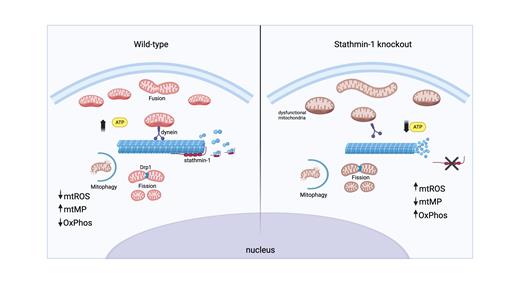Mitochondrial function is important to control HSC quiescence and self-renewal. HSCs are known to have low oxidative phosphorylation (OXPHOS), and low mitochondrial reactive oxygen species, however, studies have shown that HSCs have high mitochondrial membrane potential (MMP), which supports their function (Hinge et al 2020; Mansell et al 2021). Microtubules are important for normal mitochondrial function, acting as the main pathway through which mitochondria transport occurs.
Stathmin 1 (Stmn1) is a cytoplasmic phosphoprotein that regulates microtubule dynamics via the promotion of microtubule catastrophe or the sequestration of free alpha/beta-tubulin dimers. It is highly expressed in normal hematopoietic stem cells (HSCs) and neural tissues. Also known as oncoprotein 18 (OP18) or leukemia-associated protein 18 (LAP18), Stmn1 is overexpressed in multiple cancers, including both myeloid and lymphoid leukemias. Despite its robust expression in normal HSCs and its elevated expression in leukemias, little is known about Stmn1's role in either normal or malignant HSCs. Herein, we found that Stmn1 is a critical regulator of HSC mitochondrial and cellular function.
To determine the role of Stmn1 in HSCs, we first assessed HSC numbers and function in Stmn1 -/-mice. We determined HSC and progenitor numbers, as well as peripheral blood lineages, in young adult Stmn1 -/-mice and WT littermates. Compared to WT, Stmn1 -/- mice have mild anemia and thrombocytopenia, however, HSC numbers are similar. Despite normal HSC numbers, Stmn1 -/-HSCs had markedly impaired repopulating activity in competitive transplantation experiments (10% vs. 60% chimerism at 24 weeks p<0.0001). Similar defects in repopulating activity were found in non-competitive transplants and competitive intra-tibial transplants (done to circumvent any potential homing defects). In addition, Stmn1 -/- HSCs formed fewer colonies when plated in methocult, and were not capable of serial replating. Finally, Stmn1 -/- mice had delayed hematopoietic recovery following a single dose of the chemotherapeutic agent 5-fluorouracil (5-FU).
We next assessed the cycling and apoptosis of HSCs. Stmn1 -/- HSCs are hyper-quiescent at baseline, although they can be stimulated to cycle in response to cytokine stimulation (1.3% vs. 3.4% S/G 2/M phase at baseline and 3.4% vs. 7% S/G 2/M phase following stimulation). In addition, they have elevated levels of apoptosis compared to WT (18.5% vs. 9.90%). Consistent with its role as a microtubule destabilizer, Stmn1 expression in HSCs coincides with tubulin expression by confocal immunofluorescent microscopy, and Stmn1 -/- HSCs have decreased tubulin compared to WT HSCs.
To gain further insight into their impaired function, we next performed RNA-seq on sorted Stmn1 -/- and WT HSCs. Differential pathway analysis showed alterations in genes associated with cellular metabolism, particularly mitochondrial function (OXPHOS pathway) in the Stmn1 -/- HSCs compared to WT. Indeed, measurement of mitochondrial function using the Seahorse analyzer showed that Stmn1 -/- HSCs and progenitors have impaired maximal respiratory capacity compared to WT (251.29 vs 411.84 pmol/min). In addition, Stmn1 -/- HSCs showed reduced mitochondrial membrane potential and increased mtROS as assessed by flow-based assays. Finally, the mitochondria of Stmn1 -/- HSCs showed markedly abnormal cristae morphology by TEM, consistent with their impaired function, and Stmn1 -/- HSCs have decreased mitochondria number compared to WT (medium 12.8 vs 17.3 per 2D slice cell; p<0.0250). As elevated ROS can impair HSC function, we assessed Stmn1 -/- HSCs following treatment with MitoTEMPO, a specific scavenger of mitochondrial superoxide. Treatment of Stmn1 -/- mice with 4mg/Kg of MitoTEMPO or vehicle control for two weeks resulted in improved HSC colony formation and serial replating capacity in Methocult.
Together, these data identify Stmn1 as a critical regulator of HSC function and suggest a model whereby Stmn1 promotes normal microtubule dynamics and mitochondrial health in HSCs.
Ongoing experiments are aimed at understanding Stmn1's role in regulating mitochondrial quality control processes such as mitophagy and fission in both normal and malignant HSCs, and in elucidating the effects of Stmn1 loss on leukemic cell growth and viability.
Disclosures
No relevant conflicts of interest to declare.


This feature is available to Subscribers Only
Sign In or Create an Account Close Modal